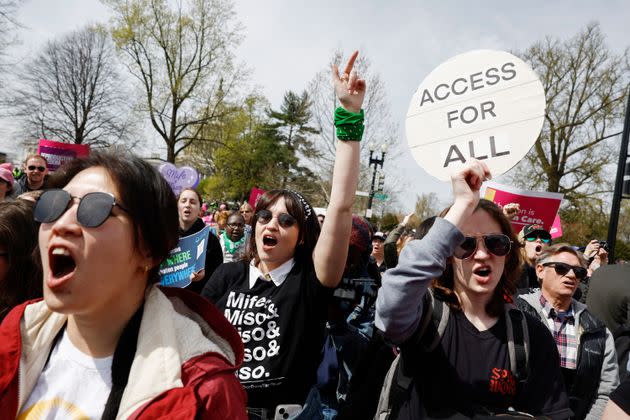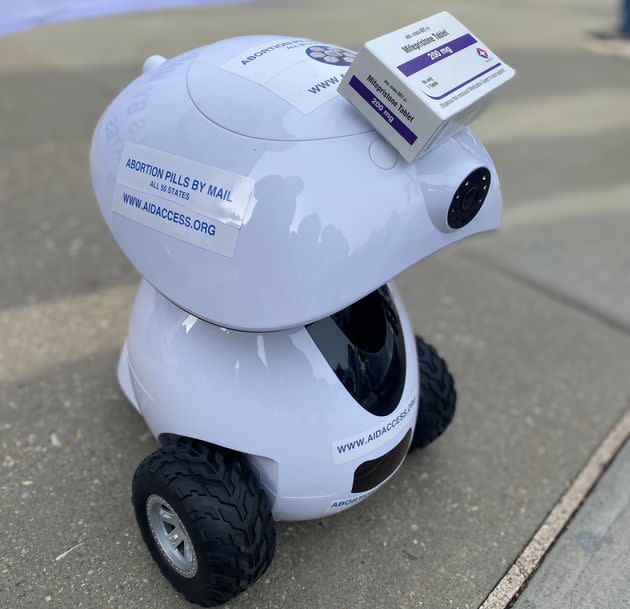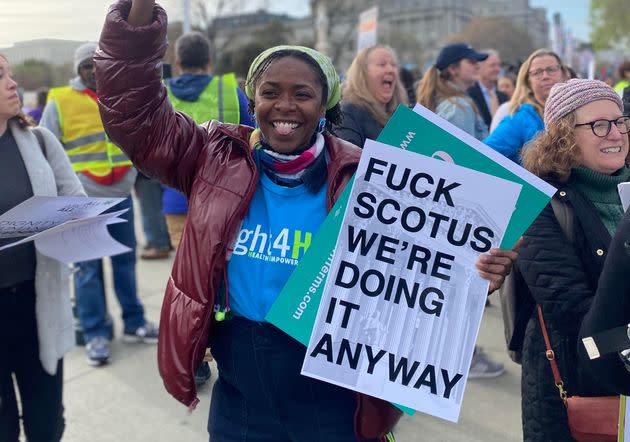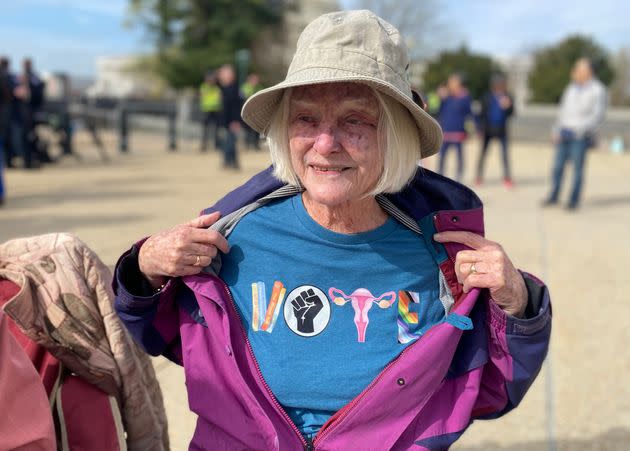Supreme Court Abortion Pill Case Draws Women Out To Fight. Again.
WASHINGTON ― Inside the Supreme Court on Tuesday, justices seemed to wonder why they were hearing a case about blocking distribution of medication abortion.
Outside the court, plenty of others were wondering how they ended up here again, on the steps of the court, fighting to protect women’s reproductive rights. Again.
“I’m 70 years old and we were talking about this when I was in college, and that’s insane to me. That, you know, 50 years later we are still fighting this fight,” said Jane Amgarola, a retired educator from Washington, D.C.
“It’s getting, you know, closer and closer to Handmaid’s Tale,” she added.
Susan, an 85-year-old woman from Chapel Hill, North Carolina, said she’s been fighting for women’s and civil rights for decades, and Tuesday’s protest at the court felt like yet another round. She was even at the 1963 March on Washington with Martin Luther King Jr.
Only one thing feels different from that day, said Susan, who asked to go by her first name.
“It’s colder now,” she said.

Hundreds of abortion rights supporters gathered outside the court as justices weighed arguments in FDA v. Alliance for Hippocratic Medicine, a case brought by conservative groups arguing that the Food and Drug Administration has too loosely regulated mifepristone, one of two drugs used in medication abortion.
The FDA firstapproved mifepristone in 2000 and says it has since been used safely by nearly six million people in the U.S. Central to the case are changes to the regulations passed by the FDA in recent years easing restrictions, including allowing it to be prescribed by telemedicine and distributed by mail.
Reproductive rights advocates showed up with their signs, their shirts with messages on them, their megaphones and the regular gear of seasoned protesters. Someone from the ACLU was handing out free fig bars as Whitney Houston’s “I’m Every Woman” blasted on a speaker somewhere. People led chants. There was a barely discernible lectern where speakers addressed the crowd to periodic cheers. A small group of pro-life activists showed up too, one of whom dramatically laid on the ground as if she had died.
Mira Michels was among the abortion rights activists on the scene. She’s a researcher with Aid Access, a New York City-based group that helps women access abortion pills in all 50 states. Michels brought a robot (a Roe-bot, get it?) that rolled around dispensing mifepristone pills. She even ate one.
“I took it in front of everyone to show how safe and effective it is,” Michels, in her 20s, said as she explained how her organization works. “An Aid Access provider in New York City will provide mifepristone, we will get it to you. Maybe it’s by mail, hand-delivered, maybe it’s by a sweet little robot. No matter what, we will get it to you.”
Asked what the pill tasted like, she said, “It tastes like freedom.”

In the arguments heard by the court on Tuesday, the justices appeared generally skeptical of the conservative doctors group’s standing in the case in the first place, questioning whether the doctors cited in the legal arguments had actually suffered relevant harm and if the case merited a nationwide ruling.
“What they’re asking for here is that, in order to prevent them from possibly ever having to do these kind of procedures, everyone else should be prevented from getting access to this medication,” Justice Ketanji Brown Jackson said while questioning the lawyer representing the doctor’s group. “So, why isn’t that plainly overbroad scope of the remedy the end of this case?”
However, other lines of questioning went differently. Justice Clarence Thomas repeatedly referenced the Comstock Act, a 150-year-old law prohibiting sending “obscene” material, including contraceptives and abortifacients, through the mail. The act, which has not been enforced for nearly a century but was never officially overturned, has been revived in recent years as a potential conservative strategy to stymie access to abortion.
For some of the older women protesting outside, who lived through Roe v. Wade becoming the law of the land in 1973, only to watch it get struck down 50 years later, the latest fight over mifepristone feels like part of something much bigger and more alarming underway.
Dona Dickinson, a 70-year-old retired computer systems architect from Great Falls, Virginia, stood in a line of women holding up letters to spell out, “PRO ROE.”
What is “frightening,” said Dickinson, is the connection between the GOP’s effort to restrict access to mifepristone and its efforts to roll back government regulations on all things, whether it’s clean water, clean air or women’s reproductive rights.
“They’re slowly dismantling all the things that protect us and the little kids and my little grandkids. It’s very scary,” she said. “Why would anybody want less clean water for their children and grandchildren? Why would you want that?”

Another woman standing nearby, Jennifer, said she’s been fighting to protect abortion rights since the 1980s, but had never taken part in a Supreme Court protest until Tuesday.
“I live in suburbia. I just recently retired. I’m very comfortable,” said Jennifer, who lives in Maryland and also requested only using her first name. “But what is happening before me, it scares the shit out of me. And I cannot stay silent.”
She lamented that the protest felt more like “a circus” and less like something that would garner serious attention by the press. There was noticeably less press in attendance than unusual, due in part to many reporters rushing to nearby Baltimore to report on Monday night’s devastating bridge collapse.
“This will be a blip in the media,” Jennifer said of the mifepristone case coverage.
But Susan, the 85-year-old from North Carolina, said the name of the game is persistence ― and young people shouldn’t stop fighting for abortion rights.
“I am being treated for skin cancer, but by God, I’m not gonna let this go,” she said, as she sat in her folding chair set up near the protest.

Susan could have single-handedly fired up the entire group if she wanted to.
She urged younger generations to fight for Supreme Court reforms like term limits on justices. She mocked the name of the conservative group coming for mifepristone (“I think it’s quite wonderful that the group is called the Hippocratic Alliance, but it’s the Hypocrite Alliance”). She opened up her jacket to show off a T-shirt that spelled out V-O-T-E, with each of the letters celebrating banned books, Black people, women and LGBTQ rights.
There is always reason for hope, Susan said, when so many people are showing up and using their voices. Beyond that, religion doesn’t just belong to conservatives, she said, noting she came to D.C. on a bus with other people from her church.
“I like the Christian answer to the question, ‘When does life begin?’” Susan said. “When the dog dies and the children leave home.”
“I’m a Christian, and that is my response.”
Lilli Petersen contributed writing.

